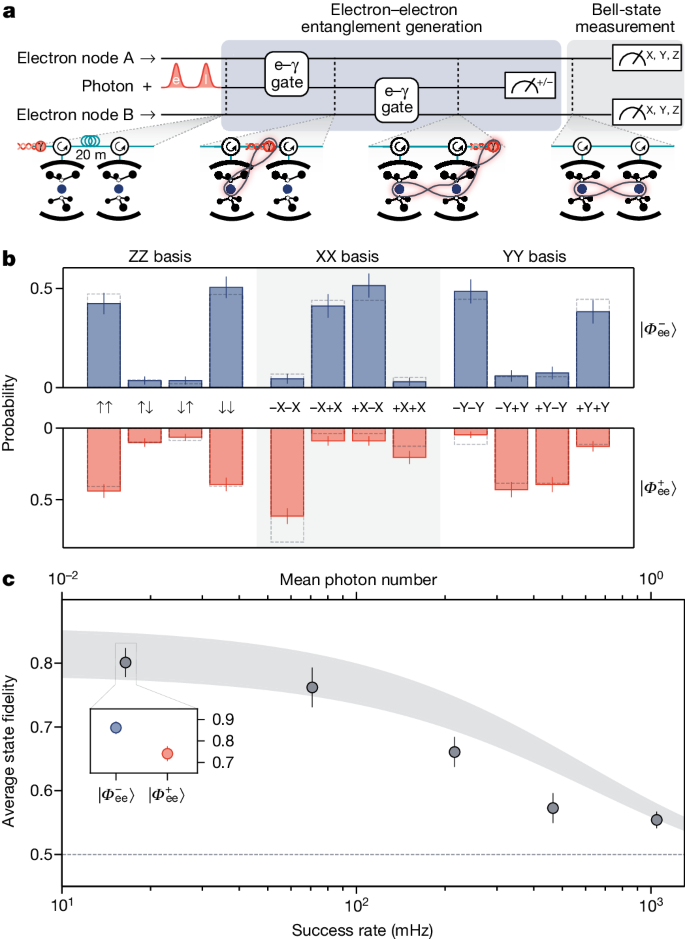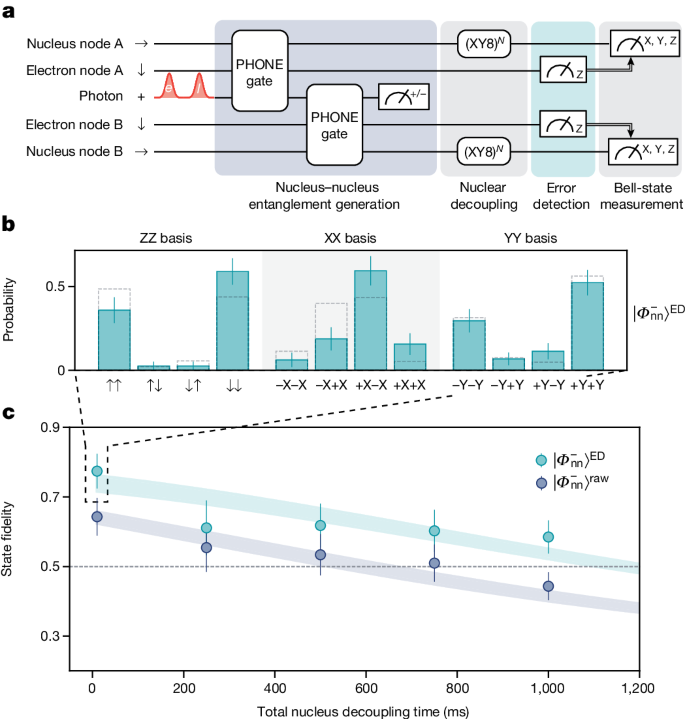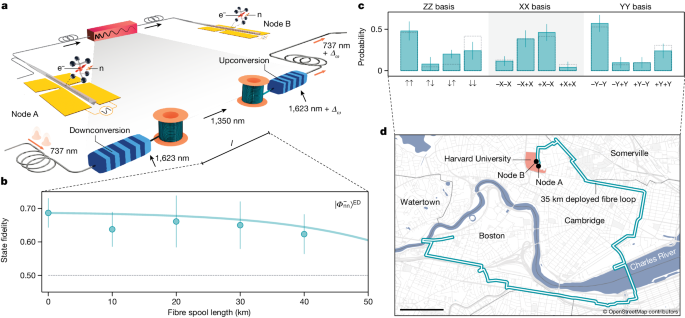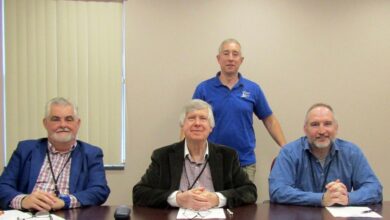Entanglement of nanophotonic quantum memory nodes in a telecom network
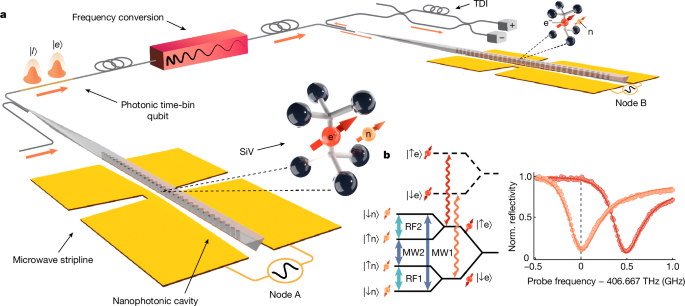
Distributing quantum entanglement between quantum memory nodes separated by extended distances1,4 is an important element for the realization of quantum networks, enabling potential applications ranging from quantum repeaters2,5 and long-distance secure communication6,7 to distributed quantum computing8,9 and distributed quantum sensing and metrology10,11. Proposed architectures require quantum nodes containing multiple long-lived qubits that can collect, store and process information communicated by photonic channels based on telecommunication (telecom) fibres or satellite-based links. In particular, the abilities to herald on successful photon arrival events and to detect quantum-gate errors are central to scalable implementations. As photons and individual matter qubits interact weakly in free space12, a promising approach to enhance the interaction between light and communication qubits is to use nanophotonic cavity quantum electrodynamic (QED) systems, in which tight light confinement inside the nanostructure enables strong interactions between the photon and the communication qubit13,14,15,16. Furthermore, nanophotonic systems offer a path towards large-scale manufacturing and on-chip electric and optical control integration17,18,19. Several experiments demonstrated remote entanglement in systems ranging from neutral atoms20,21,22,23 and trapped ions24,25 to semiconductor quantum dots26 and nitrogen-vacancy centres in diamond27,28. Recently, two atomic ensemble memories have been entangled through a metropolitan fibre network29,30,31. However, real-world applications require a combination of efficient photon coupling, long-lived heralded memory and multi-qubit operations with practical telecom fibre networks, which is an outstanding challenge.
Here we report the realization of a two-node quantum network between two multi-qubit quantum network nodes constituted by silicon-vacancy (SiV) centres in diamond coupled to nanophotonic cavities and integrated with a telecom fibre network. SiVs coupled to cavities have emerged as a promising quantum network platform, having demonstrated memory-enhanced quantum communication32 and robust multi-qubit single-node operation33. We extend these single-node experiments by demonstrating remote entanglement generation between two electron spins in two spatially separated SiV centres with a success rate of up to 1 Hz. Our approach uses serial, heralded spin-photon gate operations with time-bin qubits for robust entanglement of separated nodes and does not require phase stability across the link. We further make use of the multi-qubit capabilities to entangle two long-lived nuclear spins, using integrated error detection to enhance entanglement fidelities and dynamical decoupling sequences to extend the entanglement duration to 1 s. Both entanglement generation techniques rely on the strong light–matter interaction enabled by the coupling of SiV to the nanophotonic cavity. To demonstrate the feasibility of deployed quantum networks using our platform, we use bidirectional quantum frequency conversion (QFC) to convert the wavelength of the photonic qubits to telecom wavelengths. Building on recently demonstrated compatibility of our platform with bidirectional QFC34,35, we demonstrate remote entanglement generation through spools of up to 40 km of low-loss telecom fibre. Finally, we combine these techniques to demonstrate entanglement generation through a 35-km-long loop of fibre with 17 dB loss deployed in the Boston area urban environment.
Two-node quantum network using integrated nanophotonics
Our quantum network nodes consist of SiV centres in diamond that reside in individually operated dilution refrigerator setups in separate laboratories (Fig. 1a). By selectively implanting the 29Si isotope into the diamond substrate, each SiV deterministically contains two addressable spin qubits: one electron spin used as a communication qubit, which couples strongly to itinerant photons, and one long-lived 29Si nuclear spin, used as a memory qubit to store entanglement. Under an externally applied magnetic field, Zeeman sublevels define the electronic spin qubit states (|↓e⟩, |↑e⟩) and the nuclear spin qubit states (|↓n⟩, |↑n⟩) (refs. 36,37) (Fig. 1b, left). Microwave pulses are used to drive the electronic spin-flipping transitions, whereas radio-frequency pulses drive the nuclear spin-flipping transitions33. The SiV centres are embedded into nanophotonic diamond cavities, which enhance interactions between light and the electron spin12,38. The strong emitter–cavity coupling as characterized by the single-photon cooperativity in node A of 12.4 and node B of 1.5 (Supplementary Information) results in an electron-spin-dependent cavity reflectance14 (Fig. 1b, right). This can be used to construct a reflection-based spin-photon gate (e–γ gate), which contains a sequence of rapid microwave gates generating entanglement between the electron spin of the SiV and the photonic qubits14. Moreover, taking advantage of the strong coupling between the electron spin of SiV and the 29Si nuclear spin, nucleus–photon entanglement can be created using the photon–nucleus entangling (PHONE) gate as demonstrated recently33. The two nodes are connected either directly by an optical fibre of length a ≈ 20 m (Fig. 1a) or by a considerably longer telecom fibre link as discussed below (Fig. 4a).
a, Experimental setup. Each SiV is localized in a nanophotonic cavity within an individually operated cryostat held at temperatures below 200 mK in two separate laboratories. The line-of-sight distance between the two SiVs is 6 m. A gold coplanar waveguide is used to deliver microwave and radio-frequency pulses to the SiV. Both quantum network nodes are connected by an optical fibre of length a ≈ 20 m and frequency-shifting setup to compensate for differences in the optical transition frequencies, or a long telecom fibre link using QFC (Fig. 4a). The measurement of the photonic time-bin qubit is performed at node B using a time-delay interferometer (TDI), which measures the time-bin qubit in the basis |±⟩ ∝ (|e⟩ ± |l⟩). b, Left, energy levels of 29SiV showing the microwave and radio-frequency transitions in the two-qubit manifold (blue and turquoise arrows) and the spin-conserving optical transitions (red and orange). Right, the reflection spectrum of cavity QED system of node A shows the electron-spin-dependent cavity reflectance. The dashed line indicates the frequency of maximum reflectance contrast, which is used as the frequency for the electron spin state readout and the photonic entanglement. Norm., normalized.
We use a serial network configuration to generate remote entanglement between the electron spins in node A and node B, mediated by a time-bin photonic qubit (Fig. 2a). We first use a e–γ gate to generate an entangled Bell state between electron spin \(\left|{\downarrow }_{{\rm{e}}}^{{\rm{A}}}\right\rangle \), \(\left|{\uparrow }_{{\rm{e}}}^{{\rm{A}}}\right\rangle \) of node A and an incoming time-bin photonic qubit \(\left|e\right\rangle \), \(\left|l\right\rangle \) (ref. 14). Here, \(\left|e\right\rangle \) and \(\left|l\right\rangle \) describe the presence of a photon in the early and late time bins of the photonic qubit, which are separated by δt = 142 ns, respectively. The resulting photon–electron Bell state can be described as \(| {\rm{Photon}},{\rm{SiV}}\,{\rm{A}}\rangle =(| e{\downarrow }_{{\rm{e}}}^{{\rm{A}}}\rangle +| l{\uparrow }_{{\rm{e}}}^{{\rm{A}}}\rangle )/\sqrt{2}\) (Methods). After that, the photonic qubit travels by optical fibre to node B, in which a second e–γ gate entangles the photonic qubit with the electron spin in node B. In the ideal, lossless case, the resulting state is a three-particle Greenberger–Horne–Zeilinger (GHZ) state:
$$\begin{array}{l}| {\rm{Photon}},\,{\rm{SiV}}\,{\rm{A}},\,{\rm{SiV}}\,{\rm{B}}\rangle \,=\,(| e{\downarrow }_{{\rm{e}}}^{{\rm{A}}}{\downarrow }_{{\rm{e}}}^{{\rm{B}}}\rangle +| l{\uparrow }_{{\rm{e}}}^{{\rm{A}}}{\uparrow }_{{\rm{e}}}^{{\rm{B}}}\rangle )/\sqrt{2}\\ \,\,\,\,\,\,\,\,\,\,\,=\,(| +\rangle | {\varPhi }_{{\rm{ee}}}^{+}\rangle +| -\rangle | {\varPhi }_{{\rm{ee}}}^{-}\rangle )/\sqrt{2}.\end{array}$$
a, Entanglement generation sequence. A photonic qubit is entangled with the electron spin in node A using the e–γ gate. A second e–γ gate entangles the photonic qubit with node B, generating a GHZ state among the two electronic qubits and the photonic qubit. A measurement of the photonic qubit in the |±⟩ basis heralds the generation of an electronic Bell state \(\left|{\varPhi }_{{\rm{ee}}}^{\pm }\right\rangle \). b, Measurement results of Bell-state measurement. Measured correlations in the ZZ, XX and YY bases of the electronic spin corresponding to a Bell-state fidelity of \({{\mathcal{F}}}_{| {\varPhi }_{{\rm{ee}}}^{-}\rangle }=0.86(3)\) (blue) and \({{\mathcal{F}}}_{| {\varPhi }_{{\rm{ee}}}^{+}\rangle }=0.74(3)\) (red). Dashed bars show correlations predicted by a theoretical model using independently measured performance parameters of our system. c, Sweep of mean photon number of the photonic qubit showing that the success rates can be increased by sending photonic qubits with a higher mean photon number. The average fidelity of the generated \(\left|{\varPhi }_{{\rm{ee}}}^{+}\right\rangle \) and \(\left|{\varPhi }_{{\rm{ee}}}^{-}\right\rangle \) states is plotted. Inset, fidelities of states shown in b. Entanglement is shown to persist above the classical limit (dashed line) for success rates up to 1 Hz. Filled curves show predictions by a theory model using independently measured performance parameters of our system (Supplementary Information). Error bars in b and c are 1 s.d.
Here, |±⟩ = (|e⟩ ± |l⟩)/√2 describes two orthogonal superposition states of the photonic time-bin qubit, and \(| {\varPhi }_{{\rm{ee}}}^{\pm }\rangle =(| {\downarrow }_{{\rm{e}}}^{{\rm{A}}}{\downarrow }_{{\rm{e}}}^{{\rm{B}}}\rangle \pm | {\uparrow }_{{\rm{e}}}^{{\rm{A}}}{\uparrow }_{{\rm{e}}}^{{\rm{B}}}\rangle )/\sqrt{2}\) describes the maximally entangled Bell states of the two spatially separated electron spins. The photonic qubit is measured in the |±⟩ basis using a TDI to herald the generation of an electronic Bell state:
$$\left|{\rm{SiV}}\,{\rm{A}},{\rm{SiV}}\,{\rm{B}}\right\rangle =\left\{\begin{array}{ll}\left|{\varPhi }_{{\rm{ee}}}^{+}\right\rangle ,\quad & {\rm{if}}\,{\rm{TDI}}\,{\rm{measures}}\left|+\right\rangle \\ \left|{\varPhi }_{{\rm{ee}}}^{-}\right\rangle ,\quad & {\rm{if}}\,{\rm{TDI}}\,{\rm{measures}}\left|-\right\rangle .\end{array}\right.$$
Note that similar to the previously used single-node schemes14, this method is robust to photon loss, as any losses of photons can be detected by a missing heralding event. Furthermore, the main advantage of our serial scheme is that both the early and late time bins of the photonic qubit travel through the same path, so no phase or polarization locking is necessary to guarantee high interference contrast at the TDI. This relaxes the requirements on system stability compared with one-photon schemes, which typically require an interferometric measurement of two emitted photons travelling through two stabilized paths23,26,28,31 and avoids the reduction in entanglement rate typically present in two-photon schemes27,39. Furthermore, extending the number of network nodes to more than two can be achieved either by connecting more than two nodes in series or by using a switch network between multiple nodes to generate pairwise connectivity.
As cavity-coupled 29SiV centres possess an inhomogeneous distribution of optical transition frequencies of around ±50 GHz centred around 406.640 THz (737.2 nm), see ref. 40 and Methods, the frequency difference between the nodes needs to be coherently bridged. For node B used in this work, for instance, the optical frequency ωB of the SiV is detuned from that of node A (ωA) by Δω = 13 GHz. To address this, we prepare the photonic qubit at frequency ωA and then coherently shift its frequency by Δω after it has interacted with the SiV at node A, either using electro-optic frequency shifting or by bidirectional QFC34,35.
Electronic spin entanglement
To demonstrate the basic principles of network operation, we first focus on the nodes connected directly by an optical fibre of length a ≈ 20 m and use electro-optical frequency shifting (see Methods for more details). The above protocol is applied using weak coherent states (WCS, with mean photon number μ = 0.017) to encode time-bin qubits. After the TDI measurement heralds the generation of a Bell-state, single-qubit rotations and subsequent readout of the electron spin at each node implement the measurement of the correlations \(\left\langle {\sigma }_{i}^{{\rm{A}}}{\sigma }_{i}^{{\rm{B}}}\right\rangle ,i\in \{x,y,z\}\), which we abbreviate as XX, YY and ZZ, respectively. Figure 2b shows the results of the correlation measurements, from which we extract the fidelities of the resulting electron–electron state with respect to the maximally entangled Bell states \({{\mathcal{F}}}_{\left|{\varPhi }_{{\rm{ee}}}^{-}\right\rangle }=0.86(3)\) (if the TDI measured |−⟩), and \({{\mathcal{F}}}_{\left|{\varPhi }_{{\rm{ee}}}^{+}\right\rangle }=0.74(3)\) (if the TDI measured |+⟩), unambiguously demonstrating entanglement between the two nodes. The observed difference in fidelity is because of one source of infidelity associated with the imperfect reflection contrast of the two cavity-coupled SiVs. This results in reflection of the photonic qubit even when the electron spin is in the low-reflectivity |↓e⟩ state. For our system configuration, this type of error accumulates preferentially for the \(\left|{\varPhi }_{{\rm{ee}}}^{+}\right\rangle \) state, which is why \({{\mathcal{F}}}_{\left|{\varPhi }_{{\rm{ee}}}^{+}\right\rangle }\) is consistently lower than \({{\mathcal{F}}}_{\left|{\varPhi }_{{\rm{ee}}}^{-}\right\rangle }\) (Supplementary Information). Further error sources include contributions from 2− or higher photon number Fock states of the WCS used as time-bin photonic qubits. By varying the mean photon number μ in the WCS, we can increase the entanglement generation rate at the cost of reduced fidelity of the generated state. We explore this trade-off in Fig. 2c, in which we show that we are able to operate at success rates of 1 Hz while maintaining entanglement.
Nuclear spin entanglement
Extending remote entanglement to larger distances requires the ability to preserve entanglement long enough such that the heralding signal obtained at node B can be classically relayed to node A. The coherence times of the electron spins in nodes A and B are 125 μs and 134 μs, respectively. Assuming classical communication using optical fibres in the telecom band, the decoherence of the electron spins would limit the distance between the nodes to approximately 25 km. To overcome this limitation, we demonstrate remote entanglement generation between two 29Si nuclei, which are long-lived quantum memories with storage times of more than 2 s (ref. 33). Analogous to the generation of electron–electron entanglement, remote nuclear entanglement is mediated by the photonic time-bin qubit (Fig. 3a). Thus, the first step of the remote entanglement generation sequence is creating entanglement between a photonic time-bin qubit and the 29Si nuclear spin at node A. This is achieved using the recently demonstrated PHONE gate, which uses only microwave pulses to directly entangle the 29Si nuclear spin with the photonic qubit (see ref. 33 and Methods), without the need to swap quantum information from electron to nuclear spin. After applying the PHONE gate on the SiV in node A and the photonic qubit, in the ideal limit, their quantum state is
$$\left|{\rm{Photon}},{\rm{SiV}}\,{\rm{A}}\right\rangle =\left(\left|e{\downarrow }_{{\rm{n}}}^{{\rm{A}}}\right\rangle +\left|l{\uparrow }_{{\rm{n}}}^{{\rm{A}}}\right\rangle \right)\left|{\downarrow }_{{\rm{e}}}^{{\rm{A}}}\right\rangle /\sqrt{2}.$$
a, Entanglement generation and subsequent dynamical decoupling using nuclear spin qubits. Nuclear–nuclear entanglement is created by sequentially entangling a time-bin photonic qubit with the 29Si nuclei at nodes A and B using two PHONE gates. Measurement of the electron spin qubits allows for integrated error detection by flagging microwave gate errors that occurred during the PHONE gate. b, Results of Bell-state measurement of \(\left|{\varPhi }_{{\rm{nn}}}^{-}\right\rangle \) after performing error detection, resulting in a Bell-state fidelity of \({{\mathcal{F}}}_{\left|{\varPhi }_{{\rm{nn}}}^{-}\right\rangle }^{{\rm{ED}}}=0.77(5)\). Dashed bars show correlations predicted by a theoretical model using independently measured performance parameters of our system. c, Decoherence protection of remotely entangled nuclear–nuclear Bell states, both with (turquoise) and without (blue) error detection. By performing XY8 dynamical decoupling sequences on the two nuclei, entanglement can be preserved for up to 1 s. Filled curves show predictions by a theory model using independently measured performance parameters of our system (Supplementary Information). The XY8-1 decoupling sequence was used for the datapoint with 10 ms decoupling time, whereas the XY8-128 sequence was used for all other measurements. The dashed line indicates the classical limit. Error bars in b and c are 1 s.d.
This implies that unless a microwave gate error has occurred, the electron spin is disentangled from the nuclear spin and is in the \(\left|{\downarrow }_{{\rm{e}}}^{{\rm{A}}}\right\rangle \) state. Thus, the electron spin can be used as a flag qubit to perform error detection by discarding a measurement when the electron spin is measured in \(\left|{\uparrow }_{{\rm{e}}}^{{\rm{A}}}\right\rangle \). By performing a second PHONE gate between the 29Si nuclear spin of node B and the time-bin qubit and by subsequently measuring out the photonic time-bin qubit in the |±⟩ basis, the nuclear Bell states \(\left|{\varPhi }_{{\rm{nn}}}^{\pm }\right\rangle \) are created. Following the entanglement generation, we perform XY8-type decoupling sequences on both nuclei to protect the nuclear–nuclear Bell state from decoherence caused by a quasi-static environment. Figure 3b shows the probability correlations of the resulting \(\left|{\varPhi }_{{\rm{nn}}}^{-}\right\rangle \) state using a XY8-1 decoupling sequence with a total nuclear spin decoupling time of 10 ms. After using error detection by discarding measurements in which the electronic flag qubits are measured in the |↑e⟩ state, the Bell-state fidelity is \({{\mathcal{F}}}_{\left|{\varPhi }_{{\rm{nn}}}^{-}\right\rangle }^{{\rm{ED}}}=0.77(5)\), which is an improvement from the directly measured value of \({{\mathcal{F}}}_{\left|{\varPhi }_{{\rm{nn}}}^{-}\right\rangle }^{{\rm{raw}}}=0.64(5)\) without error detection. Similar to \(\left|{\varPhi }_{{\rm{ee}}}^{+}\right\rangle \), the generated \(\left|{\varPhi }_{{\rm{nn}}}^{+}\right\rangle \) state accumulates errors because of imperfect reflectance contrast (Supplementary Information). Figure 3c shows Bell-state fidelities for longer total nuclear decoupling times. By performing XY8–128 decoupling sequences, entanglement can be preserved for up to 500 ms, with the application of error detection further extending this to 1 s.
Entanglement distribution through 35 km of deployed fibre
Light at the resonant wavelength of the SiV (737 nm) experiences a high in-fibre loss of up to 4 dB km−1, which limits the range of remote entanglement distribution at this wavelength. To make our quantum network compatible with existing classical communication infrastructures that use low-loss optical fibres, we use bidirectional QFC to and from the telecom O-band (Fig. 4a); see the Methods. After the photonic qubit at 737 nm is reflected off the SiV of node A, a fibre-coupled PPLN waveguide pumped with 1,623 nm light converts the wavelength of the photonic qubit to 1,350 nm (ref. 34). This frequency lies in the telecom O-band and shows low attenuation (<0.3 dB km−1) in conventional telecom single-mode fibre. After downconversion, the photonic qubit is sent through telecom fibre of varying length before a second PPLN upconverts the photonic qubit back to 737 nm. This bidirectional frequency conversion allows for straightforward bridging of the frequency difference Δω of the two SiVs: the frequency of the upconversion setup of the pump laser is offset by Δω from the frequency of the downconversion pump laser. The total efficiency of the bidirectional QFC, including a final filter cavity, is 5.4%, whereas the noise counts at the superconducting nanowire single-photon detector (SNSPD) of node B are 2.5 Hz.
a, Schematic of QFC setup. At node A, the photonic qubit is downconverted from 737 nm to 1,350 nm, which can propagate with low loss in telecom single-mode fibres. At the node B, it is upconverted back to 737 nm. The pump laser frequencies in the upconversion and downconversion setups are detuned by Δω = 13 GHz to compensate for the difference in optical frequencies of the two SiVs. b, Nuclear spin Bell-state fidelities for varying lengths of telecom fibre spools between the two nodes. Entanglement persists for fibre lengths up to 40 km. Bell-state decoherence can be explained by a model incorporating a decrease in signal-to-noise ratio because of dark counts at 2.7 Hz and conversion noise photons at 2.5 Hz (solid line). The dashed line shows the classical limit. c, Measurement results of Bell-state measurement of \({\left|{\varPhi }_{{\rm{nn}}}^{-}\right\rangle }^{{\rm{ED}}}\) state created through a 35-km long deployed fibre link shown in d, resulting in a fidelity of \({{\mathcal{F}}}_{\left|{\varPhi }_{{\rm{nn}}}^{-}\right\rangle }^{{\rm{ED}}}=0.69(7)\). Dashed bars show correlations predicted by a theoretical model using independently measured performance parameters of our system. d, Route of the deployed fibre link connecting nodes A and B. It consists of 35 km deployed telecom fibre routed towards and back from an off-site location, crossing four municipalities in the greater Boston metropolitan region. Error bars in b and c are 1 s.d. Scale bar, 1,000 m (d).
Using this frequency conversion scheme together with the entanglement method described above (Fig. 3a), we remotely entangle two 29Si nuclei through spools of low-loss telecom fibre up to 40 km in length (Fig. 4b). For future repeater node applications of truly space-like separated quantum network nodes, it is important that entanglement persists until all nodes have received the classical heralding signal. To account for this effect, we execute an XY8–1 decoupling sequence for a total duration of 10 ms before performing the Bell-state measurement. The decoupling duration is much larger than the classical signal travelling time Δt(l) ≈ 200 μs for the maximal fibre length of l = 40 km. Thus, for the measured fibre distances, Bell-state decoherence does not affect the measured Bell-state fidelities. Instead, we find that the fibre-distance-dependence of the nuclear–nuclear entanglement fidelities is well described by SNSPD dark counts and telecom conversion noise photons, which reduce the signal-to-noise ratio at high fibre attenuation (solid line in Fig. 4b).
In a practical setting, large-scale quantum networks can strongly benefit from existing fibre infrastructure to allow for long-distance entanglement distribution. Deployed fibres are subject to added noise and excess loss, as well as phase- and polarization drifts34,35. We demonstrate that our system is compatible with conventional fibre infrastructure and is resilient to these error sources by generating nuclear entanglement through a 35-km loop of telecom fibre deployed in the Boston area urban environment (Fig. 4d). The overall measured loss in the loop (17 dB at 1,350 nm) exceeds the nominal fibre attenuation of 11 dB at this wavelength, indicative of excess loss typical of deployed environments. As the input polarization of the upconverting PPLN needs to align with the dipole moment of the crystal, polarization drifts introduced by the deployed fibre are actively compensated to prevent a loss in conversion efficiency (Methods). Using the deployed link, we generate entanglement with a fidelity of \({{\mathcal{F}}}_{\left|{\varPhi }_{{\rm{nn}}}^{-}\right\rangle }^{{\rm{ED}}}=0.69(7)\) (Fig. 4c), demonstrating the quantum network performance in a realistic fibre environment.
Outlook
Our experiments demonstrate key ingredients for building large-scale deployed networks using the SiV-based integrated nanophotonic platform. They open opportunities for exploration of a variety of quantum networking applications, ranging from distributed blind quantum computing41 and non-local sensing, interferometry and clock networks10,42, to the generation of complex photonic cluster states43. Extension to entanglement distribution between true space-like separated nodes using deployed fibre requires only relatively minor experimental modifications and is not limited by the performance of the quantum nodes (Supplementary Information). The success rate of the entanglement generation is currently limited by losses in the bidirectional QFC, which can be minimized by improving mode-matching into the PPLN and the efficiency of the filtering setup44. Furthermore, in-fibre attenuation could be further reduced to 0.2 dB km−1 by using two-stage QFC to 1,550 nm (ref. 45). The use of WCS also reduces the success rate and fidelity, which could be avoided by using SiV-based single-photon sources46 combined with active strain tuning of the nanophotonic cavities for wavelength matching40,47. Efficient coupling between the fibre network and the nanophotonic cavity could be improved by recently demonstrated cryogenic packaging techniques48, whereas cooling requirements of the repeater nodes could be eased by deterministic straining of SiVs49. Entanglement fidelities could be improved by working with previously demonstrated nanophotonic cavities with higher cooperativity32. Implementing the above improvements, electron–electron entanglement fidelities of about 0.95 with success rates of about 100 Hz could be achieved (Supplementary Information). Finally, the number of accessible qubits could be increased by addressing weakly coupled 13C spins50, allowing for more flexible multi-node network configurations. Combining these advances with the potential ability to create a large number of cavity QED systems fabricated on a chip, this approach can eventually result in large-scale, deployable quantum networking systems.
